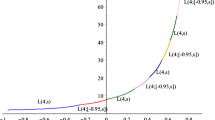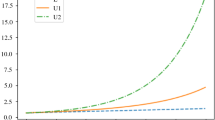Abstract
We derive and investigate lower bounds for the potential energy of finite spherical point sets (spherical codes). Our bounds are optimal in the following sense—they cannot be improved by employing polynomials of the same or lower degrees in the Delsarte–Yudin method. However, improvements are sometimes possible, and we provide a necessary and sufficient condition for the existence of such better bounds. All our bounds can be obtained in a unified manner that does not depend on the potential function, provided the potential is given by an absolutely monotone function of the inner product between pairs of points, and this is the reason we call them universal. We also establish a criterion for a given code of dimension n and cardinality N not to be LP-universally optimal; e.g., we show that two codes conjectured by Ballinger et al. to be universally optimal are not LP-universally optimal.


Similar content being viewed by others
References
Andreev, N.N.: Location of points on a sphere with minimal energy, Tr. Math. Inst. Steklova 219, 27–31 (1997) (in Russian); English translation: Proc. Inst. Math. Steklov 219, 20–24 (1997)
Ballinger, B., Blekherman, G., Cohn, H., Giansiracusa, N., Kelly, E., Schürmann, A.: Experimental study of energy-minimizing point configurations on spheres. Exp. Math. 18, 257–283 (2009)
Bannai, E., Damerell, R.M.: Tight spherical designs I. J. Math. Soc. Jpn. 31, 199–207 (1979)
Bannai, E., Damerell, R.M.: Tight spherical designs II. J. Lond. Math. Soc. 21, 13–30 (1980)
Beckermann, B., Bustamante, J., Martinez-Cruz, R., Quesada, J.: Gaussian, Lobatto and Radau positive quadrature rules with a prescribed abscissa. Calcolo 51, 319–328 (2014)
Borodachov, S., Hardin, D., Saff, E.: Minimal Discrete Energy on Rectifiable Sets. Springer, Berlin (2016). (to appear)
Boumova, S.P.: Applications of polynomials to spherical codes anddesigns, PhD Dissert, TU Eindhoven (2001)
Boyvalenkov, P.G.: Linear programming bounds for spherical codes and designs. Dr. Sci. Dissert., Inst. Math. Inf. BAS, Sofia (2004) (in Bulgarian)
Boyvalenkov, P., Bumova, S., Danev, D.: Necessary conditions for existence of some designs in polynomial metric spaces. Eur. J. Comb. 20, 213–225 (1999)
Boyvalenkov, P.G., Danev, D.P.: On Maximal Codes in Polynomial Metric Spaces. Lecture Notes in Computer Science, vol. 1255, pp. 29–38. Springer (1997)
Boyvalenkov, P.G., Danev, D.P., Bumova, S.P.: Upper bounds on the minimum distance of spherical codes. IEEE Trans. Inf. Theory 41, 1576–1581 (1996)
Boyvalenkov, P., Danev, D., Landjev, I.: On maximal spherical codes II. J. Comb. Des. 7, 316–326 (1999)
Cohn, H., Conway, J., Elkies, N., Kumar, A.: The \(D_4\) root system is not universally optimal. Exp. Math. 16, 313–320 (2007)
Cohn, H., Kumar, A.: Universally optimal distribution of points on spheres. J. Am. Math. Soc. 20, 99–148 (2006)
Cohn, H., Woo, J.: Three point bounds for energy minimization. J. Am. Math. Soc. 25, 929–958 (2012)
Davis, P.J.: Interpolation and Approximation. Blaisdell Publishing Company, New York (1963)
Delsarte, P.: An algebraic approach to the association schemes in coding theory. Philips Res. Rep. Suppl. 10 (1973)
Delsarte, P., Goethals, J.-M., Seidel, J.J.: Spherical codes and designs. Geom. Dedicata 6, 363–388 (1977)
Erdélyi, T., Magnus, A., Nevai, P.: Generalized Jacobi weights, Christoffel functions, and Jacobi polynomials. SIAM J. Math. Anal. 25, 602–614 (1994)
Hardin, D.P., Saff, E.B.: Discretizing manifolds via minimum energy points. Not. Am. Math. Soc. 51, 1186–1194 (2004)
Kabatiansky, G.A., Levenshtein, V.I.: Bounds for packings on a sphere and in space (Russian). Problemy Peredachi Informacii 14, 3–25 (1978). English translation in Problems of Information Transmission 14, 1–17 (1978)
Kolushov, A.V., Yudin, V.A.: Extremal dispositions of points on the sphere. Anal. Math. 23, 25–34 (1997)
Koornwinder, T.H.: The addition formula for Jacobi polynomials and spherical harmonics. SIAM J. Appl. Math. 25, 236–246 (1973)
Krasikov, I.: An upper bound on Jacobi polynomials. J. Approx. Theory 149, 116–130 (2007)
Levenshtein, V.I.: Bounds for packings in metric spaces and certain applications. Probl. Kibern. 40, 44–110 (1983). (in Russian)
Levenshtein, V.I.: Designs as maximum codes in polynomial metric spaces. Acta Appl. Math. 25, 1–82 (1992)
Levenshtein, V.I.: Universal bounds for codes and designs. In: Pless, V.S., Huffman, W.C. (eds.) Handbook of Coding Theory, pp. 499–648. Elsevier, Amsterdam (1998)
Matrin, W.J., Williford, J.S.: There are finitely many \(Q\)-polynomial association schemes with given first multiplicity at least three. Eur. J. Comb. 30, 698–704 (2009)
Müller, C.: Spherical Harmonics. Lecture Notes in Mathematics, vol. 17. Springer, Berlin (1966)
Musin, O.: The kissing number in four dimensions. Ann. Math. 168, 1–32 (2008)
Saff, E.B., Kuijlaars, A.B.J.: Distributing many points on a sphere. Math. Intell. 19, 5–11 (1997)
Sidelnikov, V.M.: On extremal polynomials used to estimate the size of codes. Probl. Inf. Transm. 16, 174–186 (1980)
Szegő, G.: Orthogonal Polynomials, vol. 23. AMS Col. Publ, Providence (1939)
Watson, G.N.: A Treatise of the Theory of Bessel Functions. Cambridge University Press, Cambridge (1995)
Yudin, V.A.: Minimal potential energy of a point system of charges. Discret. Mat. 4, 115–121 (1992) (in Russian). English translation: Discr. Math. Appl. 3, 75–81 (1993)
Acknowledgments
We would like to thank Dr. Silvia Boumova for kindly allowing us to include the proof of Theorem 4.4(b) so as to make this article self-contained.
Author information
Authors and Affiliations
Corresponding author
Additional information
Communicated by Vilmos Totik.
P. G. Boyvalenkov: The research of this author was supported, in part, by a Bulgarian NSF contract I01/0003.
P. D. Dragnev: The research of this author was supported, in part, by a Simons Foundation grant no. 282207.
D. P. Hardin and E. B. Saff: The research of these authors was supported, in part, by the U.S. National Science Foundation under grants DMS-1109266 and DMS-1412428.
M. M. Stoyanova: The research of this author was supported, in part, by the Science Foundation of Sofia University under contract 015/2014.
The authors express their gratitude to the Erwin Schrödinger International Institute for providing an excellent research atmosphere during which a significant part of this manuscript was written.
Appendix
Appendix
In this appendix, we give the proof of Theorem 4.4(b), which has appeared so far only in the dissertation of Boumova [7]. We set \(P_i^{(\frac{n-1}{2}, \frac{n-3}{2})}(t) := P_i^{1,0}(t)\) for short and use the Christoffel–Darboux formula (see [27, Equation (5.65)])
We also set \(P_i^{(n)}(t)=\sum _{j=0}^i a_{i,j}t^j\).
For the proof of Theorem 4.4(b), we show for each \(n\ge 3\) and s in the interior of \(I_{2k-1}\) that \(Q_{2k+3}(n,s)<0\) for k sufficiently large, and thus, by Theorem 4.1, the bound \(R_{2k-1}(n,N;h)\) can be improved. For this purpose, we present several lemmas.
Lemma 4.14
Let \(n \ge 3\), \(s \in \left( t_{k-1}^{1,1},t_k^{1,0}\right) \), and \(\alpha _i=\alpha _i(s)\), \(i=1,\ldots , k\) be the associated Levenshtein quadrature nodes, see (22). Then \(Q_{2k+3}(n,s)<0\) if and only if
Proof
This is Corollary 4.4(a) from [11]. \(\square \)
To find the sum \(\sum _{i=1}^{k} \alpha _i^2\) appearing in Lemma 4.14, we express the sums \(\sum _{i=1}^{k} \alpha _i\) and \(\sum _{1 \le i< j\le k} \alpha _i\alpha _j\) as functions of n, k, and s.
Lemma 4.15
For every \(s \in I_{2k-1}\), \(k \ge 2\), the numbers \(\alpha _1,\alpha _2,\ldots ,\alpha _k\) satisfy the equalities
where
Proof
The numbers \(\alpha _1,\alpha _2,\ldots ,\alpha _{k}\) are the roots of the equation (24)
Comparing the coefficients in (37), we obtain
Therefore, we have
Here, we used that
from (1), the constants \(r_i\) as in (2), and \(\sum _{i=0}^j r_i\), which is equal to the Delsarte–Goethals–Seidel bound D(n, 2j) (this is for \(j=k\) and \(j=k-1\)).
Similarly, we obtain
\(\square \)
It follows from Lemma 4.14 and equalities (38) and (39) that we have to investigate the sign of the function
where X is as in Lemma 4.15 and \(s \in I_{2k-1}=\left[ t_{k-1}^{1,1},t_k^{1,0}\right] \).
Lemma 4.16
For fixed n and k, the function G(n, k, s) is decreasing for \(s \in I_{2k-1}\).
Proof
The function G(n, k, s) is quadratic with respect to X. Since \(s \in \left[ t_{k-1}^{1,1},t_k^{1,0}\right] \subset \left( t_{k-1}^{1,0},t_k^{1,0}\right] \), the ratio \(P_k^{1,0}(s)/P_{k-1}^{1,0}(s)\) increases in \(I_{2k-1}\) (see [26, Corollary 2.1]). Therefore X decreases in s in the same interval, and we need to determine the numbers
and
(the end points of the interval of variation of X). We obtain
using (30) and
because \(P_k^{1,0}\left( t_k^{1,0}\right) = 0\).
We can already locate the numbers \(X_1\) and \(X_2\) with respect to the minimum of the graph of the quadratic function
The minimum of g(X) is attained at the point
We have
for every \(n \ge 3\) and \(k \ge 2\). This shows that \(X_0 < 1 = X_2 < X_1\); i.e., \(X_2\) and \(X_1\) lie on the left side of \(X_0\). Hence g(X) decreases from \(g(X_1)\) to \(g(X_2)\) when X decreases from \(X_1\) to \(X_2\). This means that G(n, k, s) decreases in s in the whole interval \(I_{2k-1}\). This completes the proof. \(\square \)
Thus we need to consider the sign of the function G(n, k, s) in the end points of the interval \(I_{2k-1}=[t_{k-1}^{1,1},t_k^{1,0}]\). Define the functions
and
From the above, we have
for all \(s \in \left( t_{k-1}^{1,1},t_k^{1,0}\right) \). We calculate \(\varphi _1(n,k)\) and \(\varphi _2(n,k)\).
Lemma 4.17
For every \(n \ge 3\) and \(k \ge 2\), we have
Proof
Plug \(X_1 = \frac{n+2k-2}{k}\) and \(X_2=1\) into g(X). \(\square \)
Theorem 4.18
Let \(n\ge 3\) and \(k \ge 9\) satisfy
Then \(Q_{2k+3}(n,s)<0\) for all \(s \in \left( t_{k-1}^{1,1},t_k^{1,0} \right) \).
Proof
For \(k \ge 9\), all values of n such that
are solutions of the inequality \(\varphi _1(n,k)<0\) (see (40)). Therefore \(G(n,k,s)<0\) for all \(s \in \left( t_k^{1,0},t_k^{1,1}\right) \) in this case. This means that \(Q_{2k+3}(n,s)<0\) for \(s \in \left( t_{k-1}^{1,1}, t_k^{1,0} \right) \). \(\square \)
Rights and permissions
About this article
Cite this article
Boyvalenkov, P.G., Dragnev, P.D., Hardin, D.P. et al. Universal Lower Bounds for Potential Energy of Spherical Codes. Constr Approx 44, 385–415 (2016). https://doi.org/10.1007/s00365-016-9327-5
Received:
Revised:
Accepted:
Published:
Issue Date:
DOI: https://doi.org/10.1007/s00365-016-9327-5
Keywords
- Minimal energy problems
- Spherical potentials
- Spherical codes and designs
- Levenshtein bounds
- Delsarte–Goethals–Seidel bounds
- Linear programming




